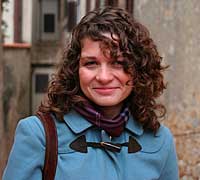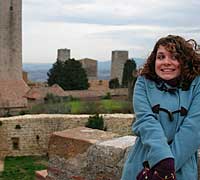JYA
Journal—Notes From Abroad
By Maggie Mertens ’09
JYA
Photo Album
Maggie Mertens in
Italy

Outside the Coliseum in Rome during winter break |

Exploring the narrow alleyways of San Gimignano in Tuscany |

Appreciating history among the ancient towers of Tuscany |
JYA Journal with:
|
I had never liked History. I
never felt much more than mildly interested during a history
class, and most often I was just bored.
That was before I came to Florence.
“Tutto d’Italia è un
museo,” my
host mother said to me one night at dinner. “All of
Italy is a museum.” Her words reflected my thoughts
since my first days here. Not only have I learned more about
art, architecture and religion just from living in an historical
city like Florence, I am also taking a history class that
I actually enjoy.
Perhaps the history of
Florence is just significantly more interesting than anything
I’ve studied before, or it
may just be the context in which I am taking this class.
For example, my teacher will relate to us an important political
action in 14th-century Florence. “And then they congregated
in the Piazza della Signoria,” he says. I turn my head
and look out the window, gazing into the Piazza where, centuries
ago, Florentines carried out their political upheavals, burning
all their witches and heretics).
After learning about the
tower-obsessed Medieval Tuscan countryside I took a day
trip to San Gimignano, one of the few medieval villages
that has preserved many of its once-protective towers.
I climbed one and found myself surrounded on all sides
by the most breathtaking panorama I have ever seen: endless
green rolling hills and vineyards—this was
Tuscany. I couldn’t help thinking this view probably
hasn’t changed much since the tower was built, and
now it is my countryside.
As a literature major,
I love the classics: Dante, Shakespeare, Tolstoy, Dostoyevsky,
Boccaccio, they all make me giddy with joy. My problem,
however, has always been putting them in some type of context.
To me, they were all written simply “in
the past”—in another century, one that I don’t
live in and that had a life and culture much different from
the one I know. In Florence I walk past the corner where
Dante used to gaze at Beatrice, the church where he was married
to another woman despite his undying love for she who overwhelms
all his works. I have been to Verona and Mantova, cities
made famous by Romeo & Juliet. These works of
literature for me now have a place attached, one I too have
seen and walked and lived.
I have entered the room
where Michelangelo carved David. I see it’s original
post every day on my way to school, and I have now studied
the real thing for hours at a time, sketching my own version.
In the Accademia the David is situated at the end of a
long hall lined with unfinished works by Michelangelo.
The forms seem to be struggling to free themselves from
their rough stone shackles, to become a piece of grandiose
perfection like their infamous counterpart. Maybe Michelangelo
never had the time to finish them, or maybe he wanted to
leave a reminder to his future admirers of the labor of a
work in progress before it becomes a masterpiece.
I never expected studying
in Italy to uncover this love for history. But as a result,
I not only understand more of the world as it was before
I came to live in it, I am now slowly finding my own place
in that vast timeline that used to just read “then,” and “now.” |























